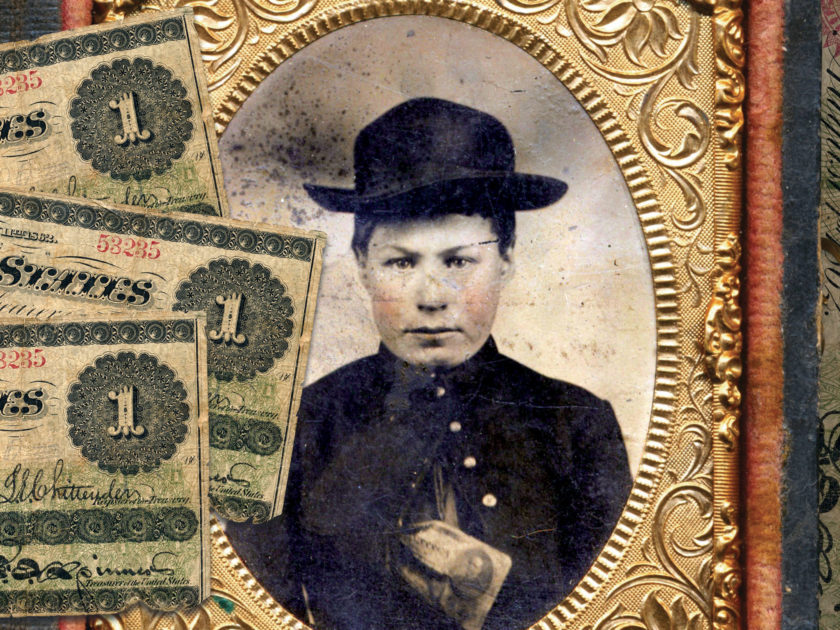By Mike Fitzpatrick
As a result of the war, the federal government suspended specie payments to maintain its bullion reserves. The move forced Congress in 1861 to authorize the U.S. Treasury to issue paper currency for the first time since the American Revolution and the earliest days of the Republic. At the same time, the federal government severely restricted the ability of state banks to issue unreliable paper money as had been the norm for many years.

This Union soldier, his youth suggestive of a drummer boy, poses with a $1 United States Demand Note, series of Aug. 1, 1862, stuffed in the open breast of his coat. Ninth-plate tintype by an anonymous photographer. Author’s Collection.
Americans nicknamed the new currency “rag money” because linen rags were used to make the paper. They were, however, officially known as Demand Notes. The bills were printed in $5, $10, and $20 denominations and promised to pay the bearer the face amount in hard cash on demand when presented at the Treasury of the United States. The Treasury authorized a total of $60 million worth of notes be printed.
In March 1862, the government replaced the Demand Notes with United States Notes, also known as Legal Tender Notes, in denominations of $1, $2, $5, $10, $20, $50 and $100. The $1 note had a portrait of Secretary of the Treasury Salmon P. Chase, while the $10 note was the first ever to carry the portrait of President Lincoln.
United States Notes were fiat money, that is, not backed by gold or silver but solely dependent on the public’s confidence in them for their stability. The public quickly dubbed them “greenbacks” because of the ubiquitous green ink used on the reverse of each note and derisively joked that the bills were backed only by the green ink with which they were printed.

Despite initial skepticism, the notes bore a statement declaring them to be legal tender for all debts except duties on imports and interest on the public debt. Some members in Congress challenged the legality of the notes on Constitutional grounds and warned that they would be dangerous and inflationary, but Secretary Chase declared them indispensable to finance the war.
War debt included monthly pay due to the soldiers in the field. The troops were supposed to be paid in cash each month, but visits by an army paymaster were often less frequent. Men chronically short of money in the ranks eagerly awaited their greenbacks. One soldier in the 67th Pennsylvania Infantry wrote home about payday, “Well we have got our pay once more and I got good and wet waiting for my turn to come. It rained hard but I can afford to git wet once for the Green Backs don’t come any too often. They are just like your letters, they don’t come neither.”
LEARN MORE about Military Images, America’s only magazine dedicated to showcasing, interpreting and preserving Civil War portrait photography.
VISIT OUR STORE to subscribe, renew a subscription, and more.

